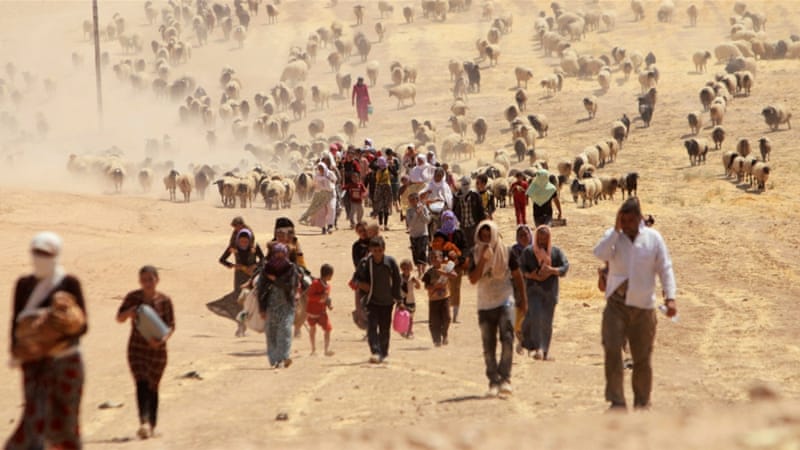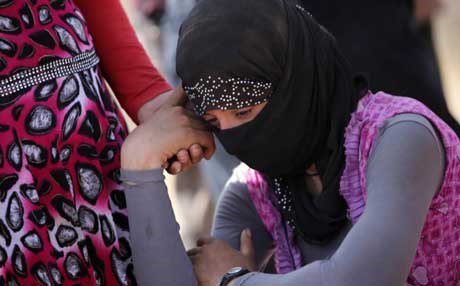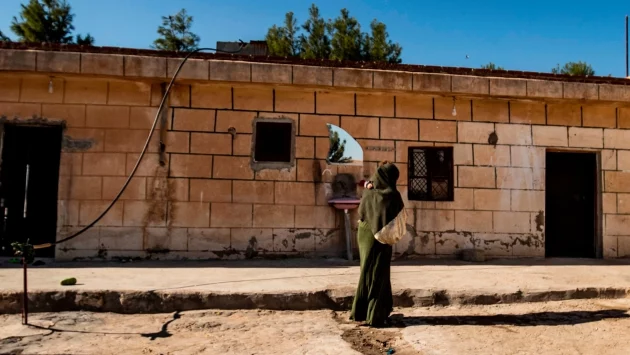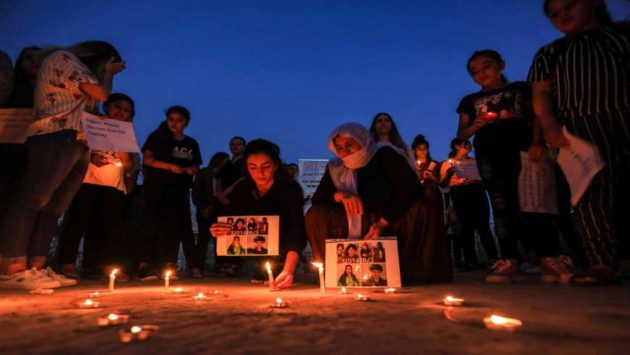Yazidis in Iraq: ‘The genocide is ongoing’
7 November 2017
Khanke camp, northern Iraq – Wahda cannot sleep. During the day, she and her husband are busy caring for their 10 daughters and two sons inside Khanke camp for displaced Iraqis, located in the country’s north. It is at night that the memories come.
“I stay awake just thinking, and I’m so angry I can’t sleep,” Wahda, 41, told Al Jazeera. “I want to take revenge for my daughters.”
Her family, who are Yazidi, lived until 2014 in Sinjar, where they owned a house, a car and a small business. The area was home to around 400,000 followers of the ancient Yazidi religion before it was stormed by fighters with the Islamic State of Iraq and the Levant group (ISIL, also known as ISIS) in August 2014.
ISIL fighters systematically murdered Yazidi men and elderly residents, and captured and enslaved women and children. The UN estimated that around 3,000 were murdered and 6,000 taken captive.
“Our neighbours were Sunni Muslims and they told ISIS where to find us,” said Wahda, who did not provide a last name. “They wanted girls and they knew that we had so many girls.”
Her family was taken into captivity, with the exception of her eldest daughter, Almas, who was visiting relatives. She was shot in the back of the head as she tried to escape.
Harrowing journey
Locked in a room, Wahda and her daughters witnessed the rape and murder of other women held captive. They were held in terrible conditions, regularly beaten and forced to convert to Islam. After two months, they escaped with the help of a friend who had learned of their captivity. After returning to Sinjar, Wahda managed to find her husband, who had survived ISIL’s massacre.
Sinjar was destroyed. After a harrowing journey across the mountain, stepping over the corpses and shallow mass graves that littered the ground, the family made it to the relative safety of Khanke camp. As Wadha recounts these events, her five-year-old daughter begins to cry.
The mass murder and enslavement of Yazidis in Iraq drew international attention. France, Germany, Canada and Australia offered asylum, while international NGOschannelled funding towards the hundreds of thousands of internally displaced Yazidis. But despite this, many have struggled to recover.
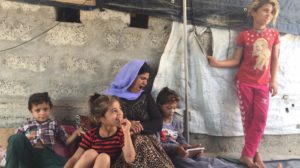
“We have had no psychological or physical support,” Wahda said. “I tried several NGOs, but either they didn’t believe me that we were held in captivity, or they said that it was only two months, which is nothing, or that we weren’t eligible because we were not raped. But my daughters’ backs were black from bruises, and we have seen a lot.”
Khider Domle, a Yazidi researcher, academic and activist based in Dohuk, told Al Jazeera that while members of the Yazidi community have been offered basic supports, it is “not for the long term”.
“Our psychological, social and religious identity has been destroyed,” Domle said. “People are living all over the place, and they don’t know what the future is. There have been no initiatives from the Iraqi government to help the displaced people return back to Sinjar; no national reconciliation process; no attempt to rebuild ruined infrastructure.”
With local and international attention diverted to the ongoing battle against ISIL in Iraq and Syria, local activists say that the momentum behind an organised aid response for Yazidis appears to have dissipated. In the meantime, people within the Yazidi community are working to help each other.
Domle, who runs a women’s centre and has been gathering testimonies from victims, is also helping to rescue the women and children who remain enslaved.
“We don’t know where they have been taken, so the genocide is ongoing,” he said, noting that part of his role is to gather information, which he then passes on to rescuers on the ground in ISIL-controlled areas. “Always, non-stop, we are working, looking, cooperating.”
Sexual slavery
Many Yazidi activists have overcome enormous tragedy themselves. Adiba Qasim was 19 when ISIL stormed Sinjar. Along with her parents and three siblings, she escaped just 15 minutes before fighters began taking hostages.
Of her extended family, 70 people went missing; a few have returned, but the majority are either in captivity or mass graves.
Qasim and her family fled to a refugee camp in Turkey, where she noticed a lack of translators for Kurmanji, the Kurdish dialect that most Yazidis speak. She also noticed that survivors of ISIL’s sexual slavery often emerged from interviews with journalists or NGO workers even more distressed than when they started.
“They were being asked things like, ‘How many times were you raped?'” Qasim said. “I decided to learn English so I could work with women.”
Qasim had never been to school, as infrastructure in Sinjar was severely lacking even before the 2014 crisis, but she had an aptitude for languages. She found scraps of paper in bins and sometimes used old cigarette packets to practise writing English words. Within months, she could speak well enough to translate for NGO workers in the camp.
After a year, she decided to return to northern Iraq to help bring the stories of Yazidi women to the world. She now works as a fixer and translator for journalists and human rights organisations.
“It’s hard to work on your own story, but I think this is the right place for me,” Qasim said. “It has been three years, and everybody knows what happened to Yazidis. Most of these women have told their stories 100 times, but they never received any help.”
When Wahda and her family found a base in Khanke camp, she embarked on a mission to find her eldest daughter’s body. Someone had told her where Almas had been buried in a shallow grave. Against all odds, Wahda eventually found it, identifying her daughter’s clothes and long black hair. She was able to give her daughter the proper burial rites, but the memory still haunts her.
A few months later, Wahda’s daughter, Inas, signed up to fight with an all-female, all-Yazidi Peshmerga unit. Now 17, she spends a third of each month on the front lines. Her camouflage fatigues are hung prominently inside the rudimentary brick structure where the family now lives.
“It’s good to be active, and to be a fighter,” Inas told Al Jazeera. “It’s better to do something than nothing. I am fighting to avenge my sister and all the girls who are still in captivity.”
The reporting for this article was supported by a Media Fellowship through the initiative on Religion and the Global Framing of Gender Violence, Center for the Study of Social Difference at Columbia University.

